mbio 1220 the innate immune system, lecture 12
1/29
There's no tags or description
Looks like no tags are added yet.
Name | Mastery | Learn | Test | Matching | Spaced |
|---|
No study sessions yet.
30 Terms
innate immunity
refers to defenses that are present at birth
these are non-specific defenses: acting against most microbes in the same way
treat everyone the same
not good! address accordingly
one site fills all
can’t modify of give a tailored response
there is no memory component: cannot recall previous contact with a foreign microbe
every time it sees E. coli it will treat it like its the first time it has been seen
first attacks
non-specific so while fighting away it affects you (why u feel yucky)
always present
responds rapidly to an infection
it is active before an infection occurs
the innate system includes
physical barriers - first line of defenses
chemical barriers - first line if defenses
cellular defenses: the second line of defense
inflammation
fever
molecule defenses
what are the first line defenses of the innate immune system?
physical barriers
chemical barriers
physical barriers
skin
mucous membranes
fluid flow
skin (biggest organ)
the outer surface of the skin consists of dead cells and protective protein called keratin
constantly moving bacteria
multi-layer dead → no vascular layer
the layers of the skin are frequently shed which removes microbes
skin is very dry which inhibits microbial growth
skin infection are more common on moist areas of the skin or in moist environments
the outer layer of the skin is an excellent defenses and is rarely penetrated by microbes
most infections occur under the skin once the skin has been broken although fungi can sometimes grow on the skin’s surface: eating dead skin cells (don’t need to eat something, micro-abrasion)
some microbes are able to eat dead skin cells and oils that are secreted by the skin
if this happens body odor results
good job of keeping bad things out
have to defend our skin
dry (but not in all areas like armpit)
skin that’s moist will have more microbial growth
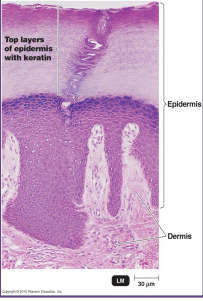
mucous membranes
these membranes are involved in fluid exchange
they offer less protection than the skin
mucous membranes line ‘tracts’ such as the digestive, reproduction, and respiratory tracts (goblets full of mucous)
they secrete mucous which is a glycoprotein that keeps the membrane from drying and cracking
the mucus traps microbes
cilia than moves the mucous containing microbes way
open outside of the body
100% contaminated
tract
fluid flow
saliva, tears, urine, and vaginal secretions move microbes away/out of the body
deportation
alt. kill each (takes so much energy)
chemical barriers
acidity of body fluids and skin
lysozyme
the normal microflora
acidity of body fluids
stomach: hydrochloric acid creates a pH of 2
this is low pH destroys many bacteria
skin: fatty acids and lactic create a pH of 3-5
these conditions prevent the growth of many microbes
when you eat your pH increases
H. pylori causes ulcers
lysozyme
an enzyme that degrades peptidoglycan
lysosome is found in sweat, tears, saliva, and nasal secretions
fragmented
cults linear chains causes bugs to be sensitive to osmolarity
cuts sections: NAM NAG NAM NAG
the normal microflora
this is acquired shortly after birth
it functions to prevent the growth of pathogens
competitive exclusion and microbial antagonism
highly protective because taking up space
cellular defenses
the second line of defense
virus got in
consists of
leukocytes which are white blood cells (WBCs)
phagocytes: white blood cells that use phagocytosis to “eat” microbes
increase in number when infection
like a vccum and take the bad guy in → has to kill while inside
there are tow types of leukocytes
granulocytes (BIG granules)
agranulocytes (small granules)
both have cytoplasm granules

granulocytes
these have large granules in their cytoplasm and are visible under light microscope
there are three sub-groups of granulocytes
basophils
these are weak phagocytes
they secrete chemo-attractants
they release histamine which usually causes allergies and inflammation
HIS → antiphallic shock, vasodilator, bronchoconstrictor
need epi pen
open up granules → disaster
eosinophils
these destroy large pathogens such as pathogenic worms
they produce extracellular digestive enzymes to attack the parasite → extra-cellular digestion *find eukaryotic problems and spit on them to digest them
neutrophils
these are strong phagocytes
they can leave the blood and enter the infected tissue
they destroy foreign microbes and particles by phagocytosis
increase permeability to capillary to allow release of neutrophils
lot of primary function to phagocytosis but don’t mind to do it. neutrophil primary function is phagocytosis
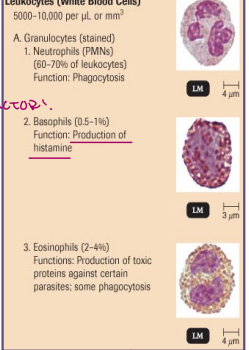
basophils
these are weak phagocytes
they secrete chemo-attractants
they release histamine which usually causes allergies and inflammation
HIS → antiphallic shock, vasodilator, bronchoconstrictor
need epi pen
open up granules → disaster
MAST CELLS: exactly like basophil but are in tissues
eosinophils
these destroy large pathogens such as pathogenic worms
they produce extracellular digestive enzymes to attack the parasite → extra-cellular digestion *find eukaryotic problems and spit on them to digest them
neutrophils
these are strong phagocytes
they can leave the blood and enter the infected tissue
they destroy foreign microbes and particles by phagocytosis
increase permeability to capillary to allow release of neutrophils
lot of primary function to phagocytosis but don’t mind to do it. neutrophil primary function is phagocytosis
agranulocytes
these also have granules in their cytoplasm which are visible under a light microscope
monocytes and lymphocytes
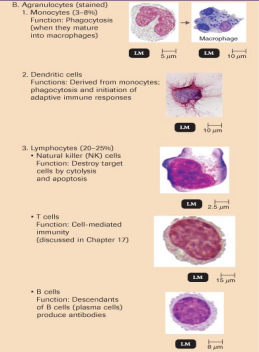
agranulocytes → monocytes
these are initially not phagocytic (baby, no job in the blood, immature)
they leave the blood, enter into tissues and become macrophages
macrophages are mature monocytes and strong phagocytes (professional phagocyte)
macrophages are often found in organs and filter out invading pathogens as blood passes through
*takes destroyed pieces and put on forehead to tell others about it and tell to learn it and find them
when neutrophil is done it vomits out the bad (but is recycled as organic material)
agranulocytes → lymphocytes
there are three types
natural killer cells (NK cells)
T and B lymphocytes
lymphocytes → natural killer cells (NK cells)
these are responsible for killing infected body cells and tumor cells (cancer)
they attack any body cell that displays unusual proteins in the plasma membrane
risk increases when stressed
kill cells that have warning on them
if destroys good things it can’t be fixed
lymphocytes → T and B
these are part of the adaptive immunity
phagocytes
during infection monocytes and granulocytes migrate to the infected area
NEED TO HAVE STIMULUS
process of eating
vacuum and now needs to clean → lysosome released to attack bug
four main phases
chemotaxis
adherence
ingestion
digestion
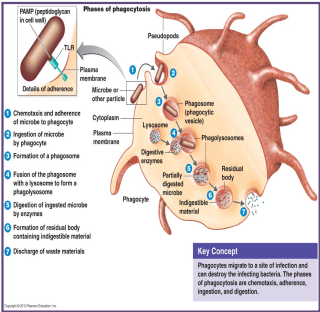
four main phases of phagocytes
chemotaxis
phagocytes are attracted to foreign particles, damaged cells etc.
adherence
phagocyte attacks to a foreign particle
ingestion
pseudopods extend and engulf the particle
the particle is trapped in the phagosome
digestion
digestion enzymes enter the phagosomes
takes 10-30 minuets to kill a bacterium
fever (heat) will lie closer to 10 mins
heat speeds up
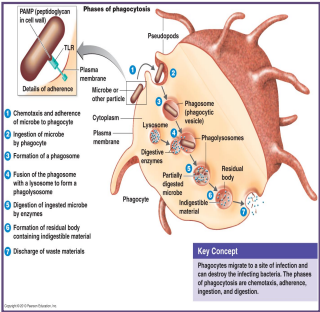
inflammation
signs and symptoms
pain
redness
heat
swelling
loss of function
inflammation functions to destroy an injurious agent
it also acts to prevent the spreading of an injurious agent
it repairs and replaces damage tissues
its a procedure → stop spread of bad guy
eliminate spread → kill in end (keep it local and deal with it)
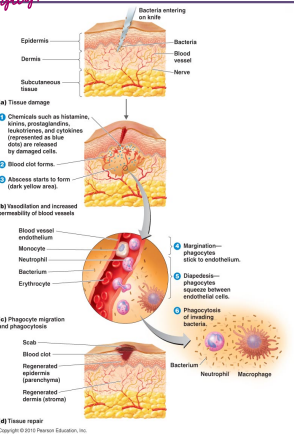
stages of inflammation
tissue damage
open your inside to bad bacteria
vasodilation → increases pathways
the blood vessels dilate: more blood reaches the affected area
this allows white blood cells to access the area
brings nutrients for faster healing
this causes reddening, swelling (edema), increased temperature, and pain
the pain is also due to tissue damage
this allows fibrinogen clot formation
this segregates the affected area
prevents the spread of infection
heat due to friction, appears more red
phagocytosis
phagocytes destroy invading microbes
increase cells that vacuum up and kill product
tissue repair
new cells are produced
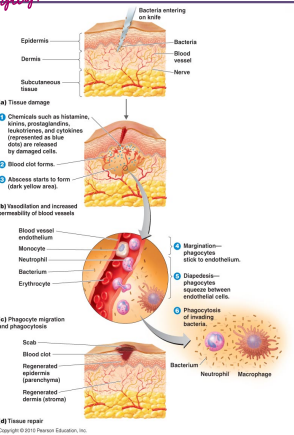
fever
an increase in body temperature
fever is controlled by hypothalamus in the brain (prostaglandin)
it is triggered by toxins, LPS, and chemicals produced by the immune system
all of these things reset the bodies thermostat
bacteria have growth curb → have optimum temp.
fever results in
muscle contractions (shivering)
increased temperature: faster metabolism, promotes healing
faster phagocytosis (due to increased temperature)
slows the growth of heat limited microbes
ex. E. coli prefers to grow at 37°C, growth slows at 40°C
up to a certain temperature, fever is a defense against disease
but a fever above 43°C can cause death
lift heat to higher volume due to contracting
bacteria has phospholipid bonds, H-bonds → destroyed by heat
Tylenol interferes with prostaglandins
molecular defenses → the complement system
composed of ~ 30 proteins that circulate in the blood
proteins help clear out threat
off if healthy
one to turn on, tags others to activate
they work together as a cascade
the action of one protein triggers the action of the next
complement can be triggered by surface molecules invading microbes
ex. Lipopolysaccharide (LPS)
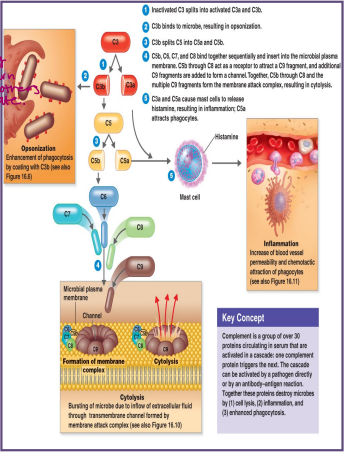
the result of the complement cascade
opsonization
C proteins attached to microbes and act as a flag to attract phagocyte
this increases phagocytosis by 1000x
done something to itself to make itself more visible
enhanced inflammation
increases blood vessel permeability
attracts phagocytes to the infection site
better because of complimentary protein
cytolysis
formation of the membrane attack complex (MAC)
pore formation
this pokes holes in the bacterial cell membrane
all fluids woosh out
gets harder to control
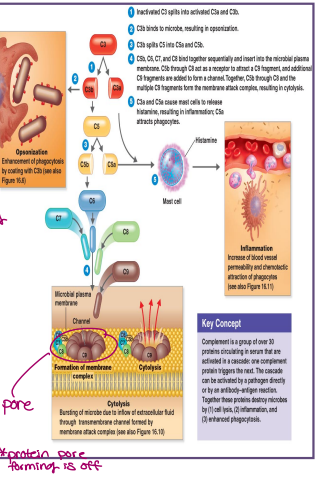
molecular defenses → interferon (IFN)
produced upon infection with a virus
it interferes with viral replication
it is released by infected cells to warn neighboring cells
allows neighboring cells time to produce anti-viral proteins
interferon does not help cells that are already infected with virus
interferon is effective only for short period of time
makes woke
tell cells to up anti-viral response
side-effects include:
nausea
fatigue
headache
vomiting
fever
interferon can be toxic to organs
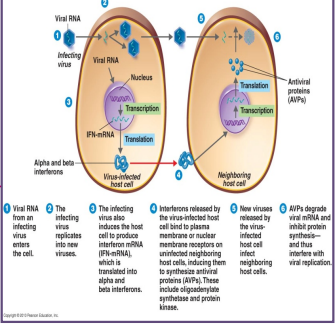
molecular defenses → transferrins
iron binding proteins in blood, milk, saliva, and tears
binds and sequesters iron so that it cannot be used by bacteria
slows bacterial growth
innate immune system
bacteria don’t have Hb, bacteria have Fe in their ETC
body grows out a sponge that sucks up Fe so it is not available for bacteria to use